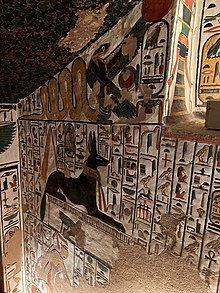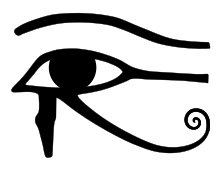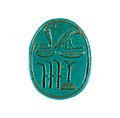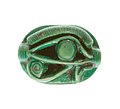Wadjet
| Wadjet | |
|---|---|
 An illustration of Wadjet based on depictions in tombs. | |
| Major cult center | Buto |
| Symbol | Egyptian cobra |
| Part of a series on |
| Ancient Egyptian religion |
|---|
 |
|
|

Wadjet (/ˈwædʒət/; Ancient Egyptian: wꜢḏyt "Green One"),[1] known to the Greek world as Uto (/ˈjuːtoʊ/; Koinē Greek: Οὐτώ) or Buto (/ˈbjuːtoʊ/; Βουτώ) among other renderings including Wedjat, Uadjet, and Udjo,[2] was originally the ancient Egyptian local goddess of the city of Dep or Buto in Lower Egypt, which was an important site in prehistoric Egypt.[3][4] Wadjet's worship originally started in the Predynastic period, but evolved over time from a local goddess to a patron goddess.[5]
Wadjet was closely associated in ancient Egyptian religion with the Eye of Ra and the Eye of Horus symbols, each powerful protective deities.[6] The hieroglyph for her eye is shown below; sometimes two are shown in the sky of religious images. There is little consensus on which eye is truly tied to Wadjet as both have some importance to her. The main differences between her eyes are which side of the face they are on, left or right.[7] The color of these eyes in amulets and ceramics are usually created in vibrant blue and green colors, which resemble the goddess's name of "the green one". The green Wadjet eye amulets found in Egyptian daily life provided a token of fertility and protection to those who had them.[8]
Etymology
[edit]The name Wadjet[9] is derived from the term for the symbol of her domain, Lower Egypt, the papyrus.[10] Its hieroglyphs differ from those of the Green Crown or Deshret of Lower Egypt only by the determinative, which in the case of the crown was a picture of the Green Crown[11] and, in the case of the goddess, a rearing cobra. The transliteration of the various eyes that Wadjet is associated with (Wedjat-eye) refers to the name the "Intact-one". Wadjet's name ends with a T, signifying her being a feminine presence rather than a male presence that some claim she is.[12] Other names for Wadjet include: Wedjat, Wadjit, Wadjyt, Uto, Buto, Uatchet, and Edjo.[13]
History
[edit]Wadjet was said to be the matron and protector of Lower Egypt in her cobra form,[14] and upon unification with her sister Nekhbet, Goddess of Upper Egypt, the joint protector and patron of all of Egypt. Scenes of the two sisters together as two cobras can be found in King Sety I's tomb, located in the Valley of the Kings.[15] The image of Wadjet with the sun disk is called the uraeus, and it was the emblem on the crown of the rulers of Lower Egypt. She was also the protector of kings and of women in childbirth, tasked with guarding them from enemies that could harm them.
Wadjet's family history is largely unconfirmed, mainly found through myth and word of mouth. In one myth, Wadjet was said to be Ra's Daughter, where she was depicted as his seeing eye. Her job was to find Shu and Tefnut for him, to which she successfully did.[16] Her father was very proud of her and honored her by commanding that she stay with him to protect him from enemies. She took her most recognizable form as a snake and struck any enemies that tried to hurt her father. She was also in charge of carrying out Ra's orders.[17] This myth is represented by triadic seals, amulets, and more, depicting the family of gods together, including Ra as the father, Wadjet as the daughter, and Seth as Ra's bodyguard.[18] A clear example of these three gods being tied together was found on a Triad amulet in Tel Azekah, closer to Jerusalem, Israel.[18]
In another myth, Wadjet was said to be the nurse of the infant god Horus.[14] With the help of his mother Isis, they protected Horus from his treacherous uncle, Set, when they took refuge in the swamps of the Nile Delta.[19]
Wadjet and Nekhbet have been portrayed as nurses to the various kings in the afterlife, breastfeeding him in order to sustain his royal qualities. These two goddesses appear in the Pyramid Texts, maintaining the king's divinity through suckling while he is in a child-like state.[20] A similar portrayal of Wadjet as a nurse, found in the tomb of Tutankhamun on a pendant, instead depicts the King as fully grown and standing straight up while being breastfed. He is dressed in his traditional royal attire, using the Goddess's milk to help him be successful in his position of king.[20] This pendant of Wadjet and the king was found in the context of funerary rituals and could serve multiple purposes of both resurrection and coronation. This imagery is also found in King Pepy II's funerary temple, which shows a damaged relief of Wadjet nursing the king.[21]
Wadjet's oracle was in the renowned temple in Per-Wadjet that was dedicated to her worship and gave the city its name. This oracle may have been the source for the oracular tradition that spread to Greece from Egypt.[22] From around the 4th dynasty onward, Wadjet was claimed as the patron goddess and protector of the whole of Lower Egypt. She became associated with Nekhbet, depicted as a white vulture, who held unified Egypt. After the unification the image of Nekhbet joined Wadjet on the crown, thereafter shown as part of the uraeus. The religious epithet for these patron deities of the entire county was, "nebty ('Two Ladies')".[23]
Wadjet, as the goddess of Lower Egypt, had a large temple at the ancient Imet (now Tell Nebesha) in the Nile Delta. She was worshipped in the area as the "Lady of Imet". Later she was joined by Min and Horus to form a triad of deities.[24] From the site of Tebtunis, in the Egyptian Faiyum, a temple is dedicated to Wadjet and was the site of ritual performance in her honor.[23]
According to ancient Greece, Wadjet was present in their mythology as well. Known as Buto, Uto, Leto or Latona, the goddess was one of the focal points for the town of Buto, as mentioned above.[25]
Appearance
[edit]
The Egyptian word wꜣḏ signifies blue and green. It is also the name for the well-known "Eye of the Moon".[26] Wadjet was usually depicted as an Egyptian cobra, a venomous snake common to the region. In later times, she was often depicted simply as a woman with a snake's head, a woman wearing the uraeus, or a lion headed goddess often wearing the uraeus. The uraeus originally had been her body alone, which wrapped around or was coiled upon the head of the pharaoh or another deity.[23] In her snake form, she was depicted as striking and biting those who try to harm the King, which is why she is featured as a protective symbol on crown emblems and amulets.[27] Wadjet is also depicted as an Egyptian cobra with large, colorful wings. She is shown in her signature green and blue colors on the snake hood and wing feathers, but she is also shown with vibrant red and gold colors that scale down to the snake's tail. Gold commonly represented the gods and goddesses eternal flesh, while red represented danger and fire to signify something as a threat.[28] A decorative panel depicting Wadjet's cobras was found in the Maru-Aten Temple in a darker colored granite. This darkened material helps historians infer that a yellow quartzite color was present, representing the color of the sun and the eternal flesh.[29] Later Wadjet often was shown coiled upon the head of Ra; in order to act as his protector, this image of her became the uraeus symbol used on the royal crowns as well.[23]

Another early depiction of Wadjet is as a cobra entwined around a papyrus stem,[19] beginning in the Predynastic era (prior to 3100 B.C.) and it is thought to be the first image that shows a snake entwined around a staff symbol. This is a sacred image that appeared repeatedly in the later images and myths of cultures surrounding the Mediterranean Sea, called the caduceus, which may have had separate origins. Her image also rears up from the staff of the "flagpoles" that are used to indicate deities, as seen in the hieroglyph for "uraeus" and for "goddess" in other places.
Similar to her sister, Nekhbet, Wadjet can also be found in the form of a vulture.[30] It is less common to find her in this form as her cobra form is more popular in order to represent protection. However some reliefs do depict Wadjet in her avian form hovering over the heads of kings and pharaohs.[30]
Wadjet is occasionally depicted as other animal headed beings or depicted as other animals such as a lion, mongoose, Ichneumonidae. Notably the depiction of the mongoose serves as an antithesis to that of the cobra as it is a natural predator. While the Icheumon probably serves as a depiction of Wedjat's role in seeing for Horus. Many bronze statues of Wadjet are argued to contain Icheumon remains however confirmation on this being forensic or a visual observation is unknown.[23]
When Wadjet is depicted as a lion, she is usually seated in the bronze statues that represent her. She is in a relaxed position with her mouth closed and her arms at her side, which is very different from her other depictions as a snake rearing at enemies. An explanation for her depiction as a lion headed goddess may stem from the goddess Sekhmet through association as a powerful or dangerous goddess.[31] Some historians are not sure that these bronze statues are of Wadjet, but instead of the goddess Sekhmet.[32]
At times she was depicted wearing the Red Crown of Lower Egypt. Wadjet was depicted many times in her cobra form alongside her Upper Egyptian counterpart Nekhbet, in her vulture form wearing the Red Crown on wall paintings or on the pharaoh's headdress.[33]
In the relief shown in the gallery, which is on the wall of the Mortuary Temple of Hatshepsut at Luxor, there are two images of Wadjet: one of her as the Uraeus with her head through an ankh and another where she precedes a Horus hawk wearing the pschent, representing the pharaoh whom she protects.

Protector of country, pharaohs, and other deities
[edit]Wadjet was associated with the Nile Delta region and was more associated with the world of the living. She was closely linked to pharaohs as a protective deity.

Wadjet is found in several different burial sites of both Kings and Queens in order to symbolize protection. Notably, she is found in Queen consort Nefertari's tomb in a rearing position wearing a double crown, or Pschent.[34] The Pschent depicts the unity of Lower and Upper Egypt into one. These crowns are usually found in the tombs of royalty in order to show control over the entirety of Egypt.[35] Along with her double crown, Wadjet is posed holding a Was-sceptre, a valued symbol of authority or divine power.[36] All of these sacred items Wadjet is posed with help to provide protection over the royal family, and in this case, the royal family is of King Ramsses II and Queen consort Nefertari.
Aside from Nefertari's tomb, Wadjet is also found in King Sety I's Tomb, along with her sister Nekhbet. The two sisters are seen on each side of King Sety's name, providing full protection to him as he rules over Egypt.[37] The unification of the sisters shows Sety I's control over all of Egypt, not just of Lower or Upper Egypt.

Wadjet, as mentioned above, is often depicted as a winged cobra. These wings serving a dual purpose as a protective embrace and being capable of creating the breath of life often connected to the image of the Ankh that she is often depicted with. Both of these uses are vital in surviving the afterlife.[23]
From the Temple of Kom Ombo an engraving depicts surgical equipment among which is a set of Wadjet eyes denoting its uses as a medical item and Wadjet's role as a protector deity. Within the wider relief it contains a depiction of a Roman pharaoh offering the Wadjet Eyes to Haroeris and Senetneferet (meaning the good sister), his consort. While only the lower portion of the relief remains, its inscription describes the pharaoh's desire for Haroeris to cleanse the eyes symbolizing the two halves of Egypt and in turn restore Egypt itself. Once again this denotes Wadjet's role as a protector and unifier of Egypt.[38]
Wadjet in Modern Media
[edit]Like many aspects of Egyptology, mass media tends to incorporate Egyptian influences into video games, movies and much more. Wadjet is no exception to this rule and is referenced in countless different forms of modern media.
- Wadjet's symbolism through the Eye of Ra appears in the video game Overwatch 2 underneath the character "Pharah's" eye.
- Wadjet's symbolism through the Eye of Horus appears in the video game Overwatch 2 underneath the character "Ana (Overwatch)"'s eye.
- Wadjet appears as the protector of Lower Egypt in The Crown of Ptolemy (March 31, 2015), by Rick Riordan.
- Wadjet's symbolism as the Eye of Horus appears within the quest, "The Curse of Wadjet", in the video game Assassin's Creed Origins.
- Wadjet appears in the board game Wadjet (board game) (1996), where she attempts to stop the explorers (players) from entering her tomb.
- Wadjet appears as a playable unit in Age of Mythology (2002) for the Egyptian Faction
Other uses
[edit]The Nazit Mons, a mountain on Venus, is named for Nazit, an "Egyptian winged serpent goddess".[39] According to Elizabeth Goldsmith, the Greek name for Nazit was Buto.[40]
Gallery
[edit]
| ||
| Wadjet - Eye of Horus in hieroglyphs | ||
|---|---|---|
-
Wadjet painted on a coffin wearing the Atef crown
-
Wadjet depicted alongside Nekhbet on a block from the mortuary temple of Hatshepsut
-
Wadjet in the form of a lioness, in the name of Akanosh son of Pediamenopet, Metropolitan Museum of Art
-
Wadjet (left) and Nekhbet (right) crowning Ptolemy VIII, Temple of Edfu
-
Stela depicting Wadjet (top right), and Nekhbet (top left), serving as protectors and unifiers of Egypt in to Stela of Tuthmosis I from Kom Bilal (near Deir el-Ballas). as seen in the Cairo, Egyptian Museum,
-
Scarab enscribed with 'The Two Ladies", Wadjet and Nekhbet protector deities of lower and upper Egypt respectively.
-
Wadjet Eye stamp seal marked with "Maatkare, Beloved of Amun".
See also
[edit]Footnotes
[edit]- ^ Also spelled Wadjit, Wedjet, Uadjet or Ua Zit
- ^ Budge, E. A. Wallis (1969). Gods of the Egyptians, The (Studies in Egyptian Mythology)
- ^ Wilkinson, Early Dynastic Egypt, p. 297
- ^ Morenz, Ludwig, "The Early Dynastic Period", in The Oxford Handbook of Egyptology (2020), p. 600
- ^ "Wadjet | Ancient Egypt Online". Retrieved 2024-02-29.
- ^ Wilksinson, Richard H. (2003) The Complete Gods and Goddesses of Ancient Egypt. Thames & Hudson. p. 227
- ^ Brown, Lawrence Parmly (November 1, 2018). "The Cosmic Eyes". The Open Court. 1918 (11): 686 – via Southern Illinois University.
- ^ admin. "Wedjat Eyes". JHU Archaeological Museum. Retrieved 2024-02-29.
- ^ Wörterbuch der ägyptischen Sprache, 1, 268.17
- ^ Wörterbuch der ägyptischen Sprache, 1, 263.7–264.4
- ^ Wörterbuch der ägyptischen Sprache, 1, 268.16;
- ^ Bagnall, Roger S.; Brodersen, Kai; Champion, Craige B.; Erskine, Andrew; Huebner, Sabine R., eds. (2013-01-30). The Encyclopedia of Ancient History (1 ed.). Wiley. doi:10.1002/9781444338386.wbeah15412. ISBN 978-1-4051-7935-5.
- ^ "Egypt: Wadjet, Goddess of Lower Egypt, Papyrus, and Protector of Pharaoh". www.touregypt.net. Retrieved 2024-03-17.
- ^ a b Pearson, Patricia O'Connell; Holdren, John (May 2021). World History: Our Human Story. Versailles, Kentucky: Sheridan Kentucky. p. 29. ISBN 978-1-60153-123-0.
- ^ Dzikowski, Francis. "Wadjet and Nekhbet". Theban Mapping Project. Retrieved 2024-03-17.
- ^ Edu, World History (2021-08-25). "Wadjet: Origin Story, Meaning, Symbols & Eye". World History Edu. Retrieved 2024-02-29.
- ^ Bianchi, Robert Steven (February 2022). "A Bronze Reliquary for an Ichneumon Dedicated to the Egyptian Goddess Wadjet". Arts. 11 (1): 21. doi:10.3390/arts11010021. ISSN 2076-0752.
- ^ a b Sweeney, Deborah; Herrmann, Christian; Koch, Ido; Gadot, Yuval; Oeming, Manfred; Lipschits, Oded (2018). "A Triad Amulet from Tel Azekah". Israel Exploration Journal. 68 (2): 129–149. ISSN 0021-2059. JSTOR 26740644.
- ^ a b "Wadjet | Egyptian goddess". Encyclopedia Britannica. Retrieved 2018-04-19.
- ^ a b Ivanova, Maria (2009). "Milk in Ancient Egyptian Religion" (PDF). Department of Archaeology and Ancient History. Retrieved March 18, 2024.
- ^ Bayoumi, Tarneem Farag (2012). "Representations of a Goddess Suckling a King in Ancient Egypt" (PDF). Egyptian Knowledge Bank. Retrieved March 18, 2024.
- ^ Herodotus ii. 55 and vii. 134
- ^ a b c d e f Bianchi, Robert Steven (2022). "A Bronze Reliquary for an Ichneumon Dedicated to the Egyptian Goddess Wadjet". Arts. 11 (1): 21. doi:10.3390/arts11010021. ISSN 2076-0752.
- ^ Vincent Razanajao, D'Imet à Tell Farâoun : recherches sur la géographie, les cultes et l'histoire d'une localité de Basse-Égypte orientale. (English synopsis)
- ^ "Pliny the Elder, The Natural History, Book V. An Account of Contries, Nations, Seas, Towns, Havens, Mountains, Rivers, Distances and Peoples Who Now Exist or Formerly Existed., Chap. 11. – The Cities of Egypt". www.perseus.tufts.edu. Retrieved 2024-02-29.
- ^ Wörterbuch der ägyptischen Sprache 1, 268.13
- ^ "ODYSSEY/Egypt/Mythology". carlos.emory.edu. Retrieved 2024-02-29.
- ^ Constantinescu, Florin-Eugen (2022). "https://www.stomaeduj.com/wp-content/uploads/BR-2-3.pdf". Stomatology Edu Journal. 9 (3–4): 130. doi:10.25241/stomaeduj.2022.9(3-4).bookreview.2. ISSN 2360-2406.
{{cite journal}}: External link in|title= - ^ "Cobra Head from Decorative Panel (Uraeus)". carnegiemnh.org. Retrieved 2024-02-29.
- ^ a b "Structure of Ritual Scenes". www.memphis.edu. Retrieved 2024-03-17.
- ^ James, T.G.H. (1982). "A Wooden Figure of Wadjet with Two Painted Representations of Amasis". The Journal of Egyptian Archaeology. 68: 156–165. doi:10.2307/3821635. JSTOR 3821635.
- ^ "Brooklyn Museum". www.brooklynmuseum.org. Retrieved 2024-02-29.
- ^ "Nekhbet and Wadjet". www.touregypt.net (in Russian). 7 July 2011. Retrieved 2018-04-19.
- ^ Egyptian Museum in Turin (March 17, 2024). "East outer thickness of Gate C in the tomb of Queen Nefertari". Theben Mapping Project. Retrieved March 17, 2024.
- ^ Society, The Egypt Exploration. "The royal crowns of Egypt". www.ees.ac.uk. Retrieved 2024-03-17.
- ^ Gordon, Andrew H.; Gordon, Andrew A.; Schwabe, Calvin W. (1995). "The Egyptian wȝs-Scepter and its Modern Analogues: Uses as Symbols of Divine Power or Authority". Journal of the American Research Center in Egypt. 32: 185–196. doi:10.2307/40000838. ISSN 0065-9991. JSTOR 40000838.
- ^ Dzikowski, Francis (April 2001). "Sety I's names flanked by Nekhbet vulture and Wadjet cobra". Theben Mapping Project. Retrieved March 17, 2024.
- ^ Coppens, Flip; Vymazalová, Hana (2010). "Medicine, Mathematics and Magic Unite in a Scene from the Temple of Kom Ombo (Ko 950)". Anthropoligie. 48 (2): 127–132. JSTOR 26292902.
- ^ "Nazit Mons". Gazetteer of Planetary Nomenclature.
- ^ Goldsmith, Elizabeth Edwards (1924). Life Symbols as Related to Sex Symbolism. Putnam. p. 429.
References
[edit]- Adolf Erman, Hermann Grapow, Wörterbuch der ägyptischen Sprache, Berlin 1963
- Ana Ruiz, The Spirit of Ancient Egypt, Algora Publishing 2001
- Bianchi, Robert Steven. 2022. "A Bronze Reliquary for an Ichneumon Dedicated to the Egyptian Goddess Wadjet" Arts 11, no. 1: 21. https://doi.org/10.3390/arts11010021
- COPPENS, FILIP, and HANA VYMAZALOVÁ. "MEDICINE, MATHEMATICS AND MAGIC UNITE IN A SCENE FROM THE TEMPLE OF KOM OMBO (KO 950)." Anthropologie (1962-) 48, no. 2 (2010): 127–32. JSTOR 26292902.
- James Stevens Curl, The Egyptian Revival: Ancient Egypt as the Inspiration for Design Motifs in the West, Routledge 2005
- Toby A. H. Wilkinson, Early Dynastic Egypt, Routledge 1999
- James, T. G. H. "A Wooden Figure of Wadjet with Two Painted Representations of Amasis." The Journal of Egyptian Archaeology 68 (1982): 156–65. https://doi.org/10.2307/3821635.
External links
[edit] Media related to Wadjet at Wikimedia Commons
Media related to Wadjet at Wikimedia Commons








